#francis pierlot
Explore tagged Tumblr posts
Text










Night Monster (1942)
"Why don't you have Millie do that, Miss Judd? That's a maid's work, not a housekeeper's. You needn't answer because I know the reason: that spot under your hand is blood and you didn't want anyone to know."
"Blood? Ridiculous."
"Yes, it is ridiculous. It couldn't be blood, but it is. I've seen those spots before and I've seen you trying to scrub them out because you knew what they were. Blood, the whole house reeks of it. The air is charged with death and hatred and something that's unclean!"
#night monster#1942#horror film#american cinema#ford beebe#clarence upson young#bela lugosi#lionel atwill#leif erickson#irene hervey#ralph morgan#don porter#nils asther#fay helm#frank reicher#doris lloyd#francis pierlot#robert homans#janet shaw#eddy waller#cyril delevanti#thoroughly enjoyable haunted house whatnot that's obviously trying to do too much but still comes out the other side a Good Time#we've got mishaps and mayhem and murders and mesmerism (not to mention medical malpractice) and all squeezed into a little over 70 minutes#(sigh those were the days). Lugosi and Atwill take top billing despite only really having supporting roles (Atwill in particular could be#better described as a cameo) but both are clearly having fun in their roles and nobody is taking this too seriously (how could they?)#gets a little messy in the back half and ends with some crucial weirdness just kind of handwaved away without proper explanation#but I'll forgive it because it's just so concerned with being a silly fun time that of course its brains fall out of the plot. one element#of the plot (a sex pest chauffeur who relentlessly pursues every woman in the film in a sinister fashion) could probably have been trimmed#back but this is still a hugely charming and (to me) entirely irresistible bit of old spooky hokum
7 notes
·
View notes
Text
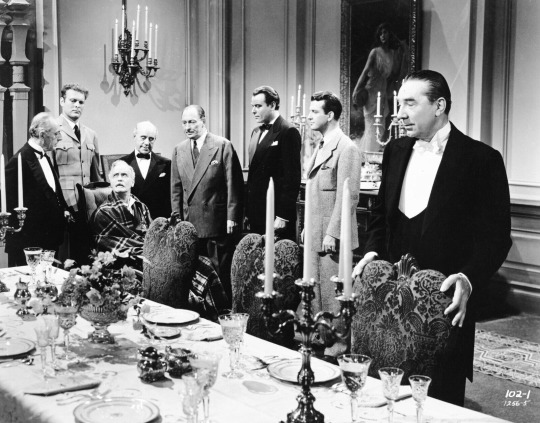
Bela Lugosi, Leif Erickson, Nils Asther, Lionel Atwill, Ralph Morgan, Francis Pierlot, Don Porter, and Frank Reicher in Night Monster (1942)
#night monster#bela lugosi#lionel atwill#leif erickson#francis pierlot#nils asther#ralph morgan#don porter#frank reicher#1942#1940s movies#ford beebe#mystery#universal horror
28 notes
·
View notes
Text
That’s My Boy
Suitable for a diverse audience, "That's My Boy" presents a blend of football, romance, and comedy.
In the span of seven years, Dean Martin and Jerry Lewis starred in sixteen movies together. That’s quite an accomplishment for such a short amount of time. While their partnership was not sustainable and led to a messy split, we have their movies to get an idea of what was once a great partnership. Their fourth installment, the Hal Walker directed, and Cy Howard written, “That’s My Boy” (1951),…

View On WordPress
#comedy#Cy Howard#Dean Martin#Eddie Mayehoff#Film#Francis Pierlot#Gregg Palmer#Hal Walker#Hazel Boyne#Hugh Sanders#Jerry Lewis#John McIntire#Lillian Randolph#Marion Marshall#Movie Review#Movies#musical#Polly Bergen#Ruth Hussey#Selmer Jackson#Sport#Tom Harmon
3 notes
·
View notes
Photo


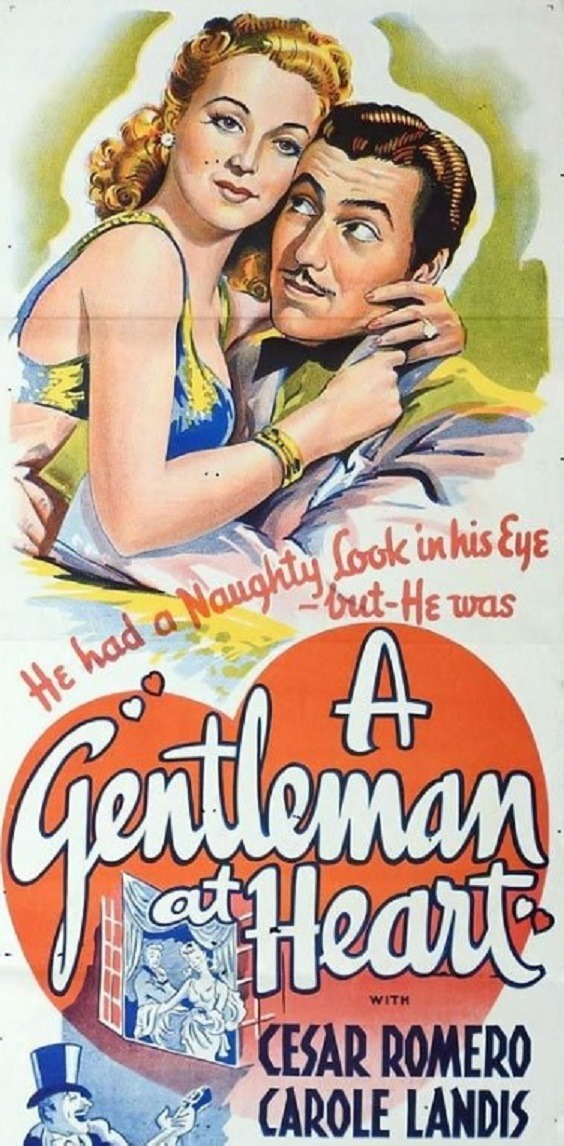






A Gentleman at Heart (1942) Ray McCarey
May 16th 2023
#a gentleman at heart#1942#ray mccarey#cesar romero#carole landis#milton berle#j. carrol naish#elisha cook jr.#francis pierlot#rose hobart#jerome cowan#richard derr
3 notes
·
View notes
Text
Dread by the Decade: Night Monster
👻 You can support me on Ko-Fi! ❤️

★★
Plot: A man invites the doctors responsible for his declining health to his isolated mansion, where they are picked off one-by-one.
Review: Despite decent aesthetics, this film's horror is too sparse and its pace too dry to make up for its rather silly main idea.

Year: 1942 Genre: Supernatural Horror, Mystery, Gothic Country: United States Language: English Runtime: 1 hour 13 minutes

Director: Ford Beebe Writer: Clarence Upson Young Cinematographer: Charles Van Enger Editor: Jack Otterson Composer: Hans J. Salter Cast: Irene Hervey, Don Porter, Ralph Morgan, Fay Helm, Lionel Atwill, Frank Reicher, Francis Pierlot, Nils Asther, Bela Lugosi, Doris Lloyd

-----
Story: 2/5 - Despite some genuine mystery, it grows plodding, consisting mostly of people delivering dry dialogue before a rushed climax.
Performances: 3/5 - The cast is mostly natural, save for Asther, whose portrayal of an Indian man is laughable.
Cinematography: 3.5/5 - Good atmospheric lighting. The fog shots are surprisingly decent.
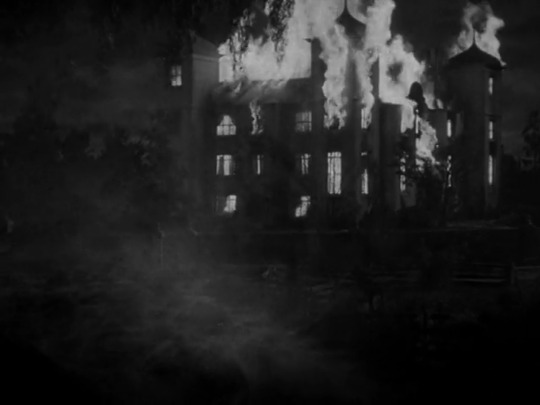
Editing: 3/5 - Smooth and coherent.
Music: 2.5/5
Effects & Props: 2.5/5 - Fluctuates between decent and cheap.
Sets: 4/5 - The ornate mansion is lovely and elaborate, with a particularly striking stairwell set.
Costumes, Hair, & Make-Up: 3/5
youtube
Trigger Warnings:
Minor violence
Suicide
Attempted sexual assault
Sexual harassment
Brownface
Inaccurate, racist portrayal of Hindu beliefs
Misogyny (uncritical)
Ableism (uncritical)
#Night Monster (1942)#Night Monster#Ford Beebe#American#supernatural horror#gothic#Dread by the Decade#review#1940s
3 notes
·
View notes
Text

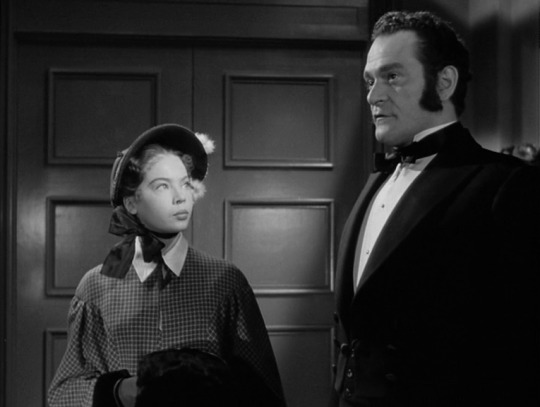


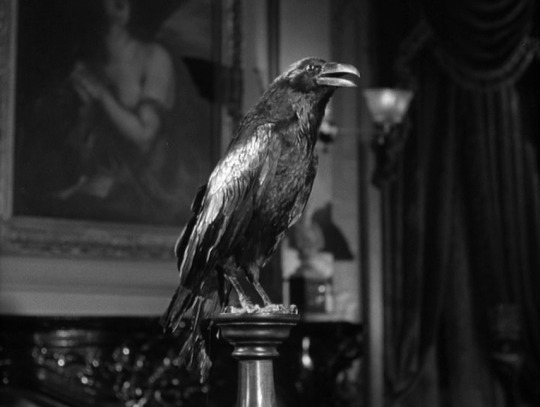

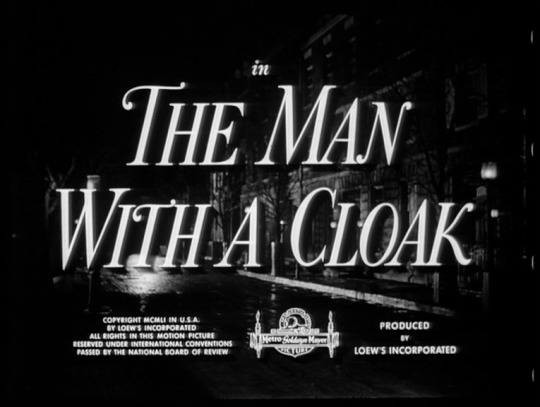

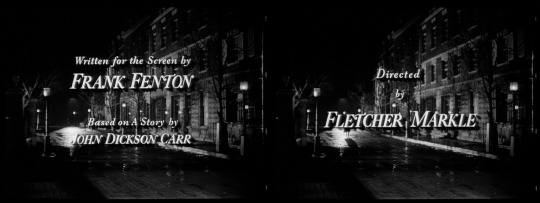
I'm in an interesting house. Handsomely upholstered in margue, with an old and dying reprobate as master, butler like a professional wrestler, and his housekeeper, she was once the toast of an era. The Man with a Cloak - Fletcher Markle (1951)
#Fletcher Markle#The Man with a Cloak#The Gentleman from Paris#John Dickson Carr#crime#thriller#Dupin#Joseph Cotten#Barbara Stanwyck#Louis Calhern#Leslie Caron#Joe De Santis#Jim Backus#Margaret Wycherly#Richard Hale#Nicholas Joy#Roy Roberts#Mitchell Lewis#Jean Inness#Francis Pierlot#François Villon
3 notes
·
View notes
Text

Aline MacMahon, Burt Lancaster, and Gordon Gebert are mother, son and grandson in a scene from The Flame and the Arrow (1950) with Francis Pierlot as Papa Pietro. The film was photographed by Ernest Haller. This is Ernie's second honorable mention, after In This Our Life with Bette Davis. He has eight entries among my best 1,001 movies, including Gone with the Wind and three with Bette - Dark Victory, Jezebel, and Whatever Happened to Baby Jane.
0 notes
Photo

Night Monster
Night Monster is horrific tale filled with strange characters, secret passages, dark storms and a murderer who has mastered the art of “mind over matter”. Kurt Ingston (Ralph Morgan) is a helpless cripple due to the incompetence of three doctors (Lionel Atwill, Frank Reicher, Francis Pierlot). He invites them to visit him at his estate on the pretext of donating money to medicine. One by one, the doctors are mysteriously murdered. The spooky mansion is filled with strange characters, any one of whom could be the killer. There is the ominous butler (Bela Lugosi), the grim housekeeper (Doris Lloyd), the lecherous chauffeur (Leif Erikson), a mystic (Nils Asther) and Ingston’s demented sister (Fay Helm). Trying to solve the murders – and stay alive – are a psychiatrist (Irene Hervey) and a mystery writer (Don Porter).
DVD from Amazon
27 notes
·
View notes
Link
For just $3.99 Released on March 2, 1946: A college student kills a pawn broker to get enough money to finish school, and experiences great fear as the cops play a cat-and-mouse game with him. Genre: Drama Duration: 1h 37min Director: Alfred Zeisler Actors: Peter Cookson (Larry Crain), Warren William (Police Captain Burke), Anne Gwynne (Eileen Stevens), Francis Pierlot (Professor Stanley), Nestor Paiva (Detective Shaefer), James Cardwell (Ben, a student), Almira Sessions (Mrs. Williams, landlady), William Moss (Al), Harry Clay (student), Johnny Strong (student), Ernie Adams (house painter), Charles Calvert (Doc), Phyllis Ayres (pedestrian), Tony Barrett (narrator), Ken Broeker (uniformed officer), Fairfax Burger (magician), James Conaty (man in police station), Chester Conklin (railroad switchman), Bubbles Hecht (blonde), Hy Jason (pedestrian), Carl M. Leviness (tailor), Darren McGavin (blonde student), Pat McKee (second bartender at the Sea Hawk), Winnie Nard (pedestrian), Paul Newlan (first bartender at the Sea Hawk), Jack Richardson (pedestrian), Cedric Stevens (unknown), Brick Sullivan (policeman), Lee 'Lasses' White (janitor) *** This item will be supplied on a quality disc and will be sent in a sleeve that is designed for posting CD's DVDs *** This item will be sent by 1st class post for quick delivery. Should you not receive your item within 12 working days of making payment, please contact me so we can solve this or any other questions. Note: All my products are either my own work, licensed to me directly or supplied to me under a GPL/GNU License. No Trademarks, copyrights or rules have been violated by this item. This product complies with rules on compilations, international media, and downloadable media. All items are supplied on CD or DVD.
0 notes
Photo
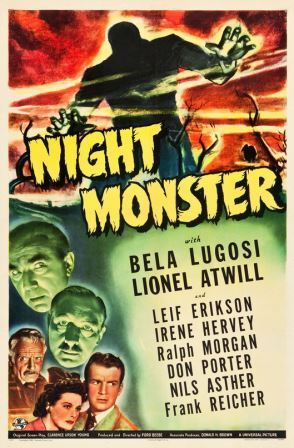
New Post has been published on http://www.classicfilmfreak.com/2017/09/07/night-monster-1942-starring-bela-lugosi-lionel-atwill/
Night Monster (1942) starring Bela Lugosi and Lionel Atwill
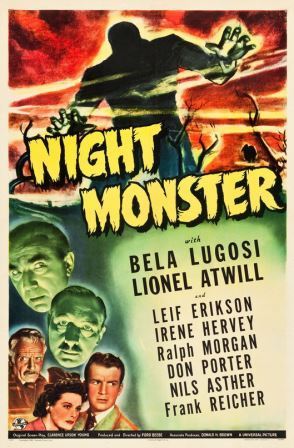

When the frogs stop croaking . . . watch out!
The beginning of Night Monster is rather subdued but with enough hints of disquiet and mystery to stimulate the interest. In keeping with the body-plentiful tradition of Universal horror films of the ’30s and ’40s, there will be eight deaths, including one which has occurred before the movie begins. Distracting from this, however, is the talky script, which has a positive effect, extending the suspense between body-findings.
At the fog-enshrouded Ingston mansion, the gate keeper (Cyril Delevanti, Deborah Kerr’s grandfather in The Night of the Iguana, 1964) opens the gate for a man who apparently has walked down the dirt road from nowhere. Inside the house, he sees the housekeeper, Sarah Judd (Doris Lloyd, the Baroness Ebberfeld in The Sound of Music, 1956), on her knees, scrubbing a spot on the carpeted steps of an elaborate staircase.
The man, who wears a turban, watches from behind a balustrade as Margaret Ingston (Fay Helm, Mrs. Fuddle in the Blondie series, 1938-50), daughter of the household head, approaches Judd and accuses her of cleaning blood from the carpet. The two argue, Margaret insisting she isn’t insane and the housekeeper finally sending her to her room—a servant giving orders to her employer?
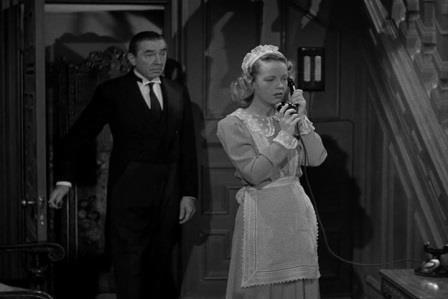
Later, the maid, Milly Carson (Janet Shaw, the waitress at the Till Two bar in Alfred Hitchcock’s Shadow of a Doubt, 1943), descends the staircase and phones the local constable. Her warnings about the strange goings-on in the Ingston household are cut short by the butler, Rolf (Bela Lugosi), who quietly emerges through the door behind her. She gives her notice and prepares to leave.
With this atmosphere—the sense of unrest, the suspicious characters and the underlying creepy music—the mood is set. . . .
Despite the bodies that will accumulate, the two top-billed stars in Night Monster step outside their usual sinister roles, their names used here for their marquee value. Lugosi, well into a physical and mental collapse, is relegated to the role of butler, either announcing dinner, summoning guests to the library or finding bodies. The Human Monster, back in 1940, is the last film to qualify as a true Lugosi vehicle.
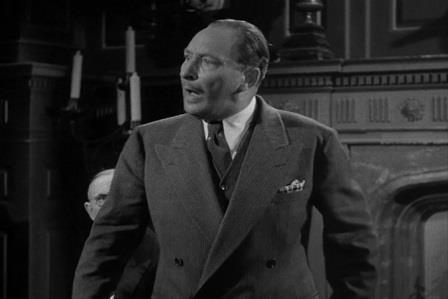
Lionel Atwill, though much more of a star than his two doctor companions, is the first of the three to be dispatched, after only a brief time on screen. 1942 was one of his busiest years, playing doctors in both The Mad Doctor of Market Street and The Ghost of Frankenstein, and important roles in To Be or Not to Be and Sherlock Holmes and the Secret Weapon as Moriarity opposite Basil Rathbone’s Holmes. He appeared in nine films that year.
Directed by Ford Beebe, Night Monster comes at a time when the luster of Universal as the master of horror is clearly in decline. The abundant fog around the Ingston mansion, and on the much-traveled road leading to it, is essential to hide a barren set. The elaborate two-level staircase appears in many of the studio’s films.
Much of the spirit and many of the trademarks of Universal, however, still shine through. Hans J. Salter’s music, one of the strongest ingredients in the film, provides an eerie atmosphere, starting with the main title, which would be reused in The Ghost of Frankenstein. Behind the opening credits, as so often in the studio’s horror movies, the camera traverses those familiar, desolate, foggy woods, as in The Wolf Man (1941).
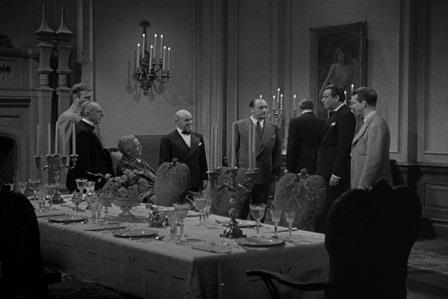
Charles Van Enger, rather undistinguished as cinematographers go, was nonetheless a stalwart of Universal and Warner Bros. His greatest claim to fame is his uncredited work on the 1925 Lon Chaney, Sr. Phantom of the Opera. He spent the last years of his career in television—Lassie, The Betty Hutton Show, Gilligan’s Island and many others.
Returning to the doings at the mansion, Laurie, the lecherous chauffeur (Leif Erickson, best known for TV’s The High Chaparral, 1967-71), has been sent by the head of the household, Kurt Ingston (Ralph Morgan, brother of Frank, Professor Marvel in The Wizard of Oz, 1939), to the train station to pick up three doctors.
Doctors King (Atwill), Timmons (Frank Reicher, the ship captain in King Kong, 1933) and Phipps (Francis Pierlot, player of small roles, such as Herkimer in Anne of the Indies, 1951) had earlier attended the wheelchair-bound Ingston, who, after his “major illness,” as King describes it, is now without arms and legs.
Ingston seems free of grudges, saying the doctors did all that medical science allowed. “I don’t think you’ve ever been properly rewarded,” he tells them at dinner. “But you will be. You will be.”

Summoned by Margaret Ingston, a fourth doctor, psychiatrist Lynn Harper (Irene Hervey, her last movie role was in Clint Eastwood’s Play Misty for Me, 1971), is en route when her car breaks down. Walking down the road toward the mansion, she hears a scream, just after the frogs had stopped croaking, but fortunately meets a car driven by a frequent visitor to the Ingstons, Dick Baldwin (Don Porter, most adept in comic roles in both movies and TV).
With patches of blood near the body, a strangled Milly—the source of the scream—is found by Constable Cap Beggs (Robert Homans, grim-faced actor of countless judges and law officers). Beggs was alerted by the buggy-driving Jed Harmon (Eddy Waller, character actor in many a Western) of the suspicious whereabouts of the maid.
The eavesdropping man with the turban turns out to be a live-in guest, an Eastern mystic, Agor Singh (Niles Asther, a Danish actor who once proposed, unsuccessfully, to Greta Garbo). In an incomprehensible discourse to guests in the library, Singh explains how rearranging “cosmic substances” can materialize objects through deep concentration.
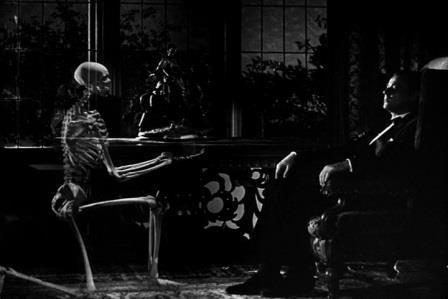
He demonstrates by evoking a kneeling skeleton—the undoubted work of Universal’s special effects master John P. Fulton, though no screen credit is given. Singh says certain details in the process, such as the residual blood, even after the skeleton itself has disappeared, cannot be explained to the “uninitiated.”
During a later scene in the library, Rolf enters to summon everyone to the room of Dr. King—strangled by his bed, only a claw-like hand visible and blood blotches on the floor. Then, between various stretches of dialogue, follows the similar death of Dr. Timmons, a hand clutching the bedspread. After Dr. Phipps has also been strangled, Baldwin and Beggs follow the blood to a secret passage (a set from The Cat and the Canary, 1939).
Margaret argues with housekeeper Judd and sets fire to the house in a fit of insanity while, outside in the woods, Baldwin and Harper are being stalked by a shadowy, stiff-walking man. It’s Kurt Ingston! But he’s . . . walking! (Was there ever any doubt that he was the murderer? A man in a wheelchair should always be the first suspected—and, quite often, he’ll be the killer.)
Failing to kill Baldwin, Ingston tries to strangle Harper, but Singh appears and shoots him, his legs gradually dematerializing as he dies. In the background, flames consume the Ingston mansion—the same model used in The Ghost of Frankenstein.
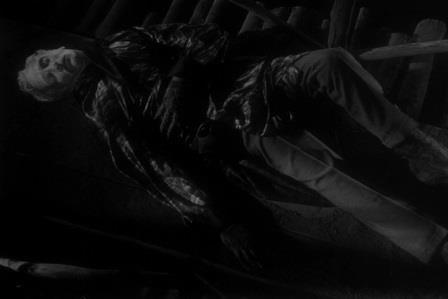
For what it is, Night Monster isn’t all that bad. Of course it never escapes its class “B” horror status, not that it tries or wants to, but it has a certain measured, suspenseful pace. The key murders, Milly’s aside, are sensitively spaced, beginning later in the plot than perhaps expected. While Calvin Thomas Beck, for example, accords the movie only one line in passing, justified in the context of his Heroes of the Horrors, as it’s not a Lugosi vehicle, a number of other critics give Night Monster surprisingly high marks. A competent cast moves about in sharp black-and-white photography, and the premise of materializing legs to commit murder is a little different.
And what better way to end a horror movie about a ridiculous, untenable premise than with an appropriately empty warning, presumably to those who might try rearranging those cosmic substances: “A little knowledge of the occult is dangerous,” Singh ruminates in the film’s last lines. “Unless it’s used for good, disaster will follow its wake. That is Cosmic Law.”
Let that be a lesson.
https://www.youtube.com/watch?v=eoaL3ClDuX4
0 notes
Photo




Fear (1946) Alfred Zeisler
November 20th 2020
#fear#1946#alfred zeisler#peter cookson#warren william#anne gwynne#nestor paiva#almira sessions#francis pierlot#suspense#black tower
10 notes
·
View notes